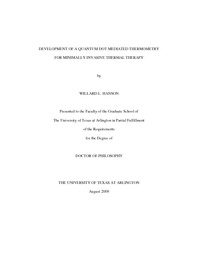
ATTENTION: The works hosted here are being migrated to a new repository that will consolidate resources, improve discoverability, and better show UTA's research impact on the global community. We will update authors as the migration progresses. Please see MavMatrix for more information.
Show simple item record
| dc.contributor.author | Hanson, Willard L. | en_US |
| dc.date.accessioned | 2009-09-16T18:19:55Z | |
| dc.date.available | 2009-09-16T18:19:55Z | |
| dc.date.issued | 2009-09-16T18:19:55Z | |
| dc.date.submitted | January 2009 | en_US |
| dc.identifier.other | DISS-10397 | en_US |
| dc.identifier.uri | http://hdl.handle.net/10106/1800 | |
| dc.description.abstract | Thermally-related, minimally invasive therapies are designed to treat tumors while minimizing damage to the surrounding tissues. Adjacent tissues become susceptible to thermal injury to ensure the cancer is completely destroyed. Destroying tumor cells, while minimizing collateral damage to the surrounding tissue, requires the capacity to control and monitor tissue temperatures both spatially and temporally. Current devices measure the tumor's tissue temperature at a specific location leaving the majority unmonitored. A point-wise application can not substantiate complete tumor destruction. This type of surgery would be more effective if volumetric tissue temperature measurement were available. On this premise, the feasibility of a quantum dot (QD) assembly to measure the tissue temperature volumetrically was tested in the experiments described in this dissertation. QDs are fluorescence semiconductor nanoparticles having various superior optical properties. This new QD-mediated thermometry is capable of monitoring the thermal features of tissues non-invasively by measuring the aggregate fluorescence intensity of the QDs accumulated at the target tissues prior to and during the surgical procedure. Thus, such a modality would allow evaluation of tissue destruction by measuring the fluorescence intensity of the QD as a function of temperature. The present study also quantified the photoluminescence intensity and attenuation of the QD as a function of depth and wavelength using a tissue phantom. A prototype system was developed to measure the illumination through a tissue phantom as a proof of concept of the feasibility of a noninvasive thermal therapy. This prototype includes experimental hardware, software and working methods to perform image acquisition, and data reduction strategic to quantify the intensity and transport characteristics of the QD. The significance of this work is that real-time volumetric temperature information will prove a more robust tool for use in thermal surgery. The thermal ablation zone is extremely diffusive and current imaging techniques and/or equipment may not accurately monitor portions of the tumor surviving the ablation process. Used in conjunction with other volumetric measuring systems, i.e., fluorescence or bioluminescence tomography, this platform will have the capacity to produce direct three dimensional intraoperative monitoring of the thermal surgical procedure. Lastely, realization of system requirements will aid in the automation of imaging to ease data acquisition, maximize exposure, and control test bed temperature. | en_US |
| dc.description.sponsorship | Han, Bumsoo | en_US |
| dc.language.iso | EN | en_US |
| dc.publisher | Mechanical Engineering | en_US |
| dc.title | Development Of A Quantum Dot Mediated Thermometry For Minimally Invasive Thermal Therapy | en_US |
| dc.type | Ph.D. | en_US |
| dc.contributor.committeeChair | Han, Bumsoo | en_US |
| dc.degree.department | Mechanical Engineering | en_US |
| dc.degree.discipline | Mechanical Engineering | en_US |
| dc.degree.grantor | University of Texas at Arlington | en_US |
| dc.degree.level | doctoral | en_US |
| dc.degree.name | Ph.D. | en_US |
| dc.identifier.externalLink | http://www.uta.edu/ra/real/editprofile.php?onlyview=1&pid=245 | |
| dc.identifier.externalLinkDescription | Link to Research Profiles | |
Files in this item
- Name:
- Hanson_uta_2502D_10397.pdf
- Size:
- 4.471Mb
- Format:
- PDF
This item appears in the following Collection(s)
Show simple item record


